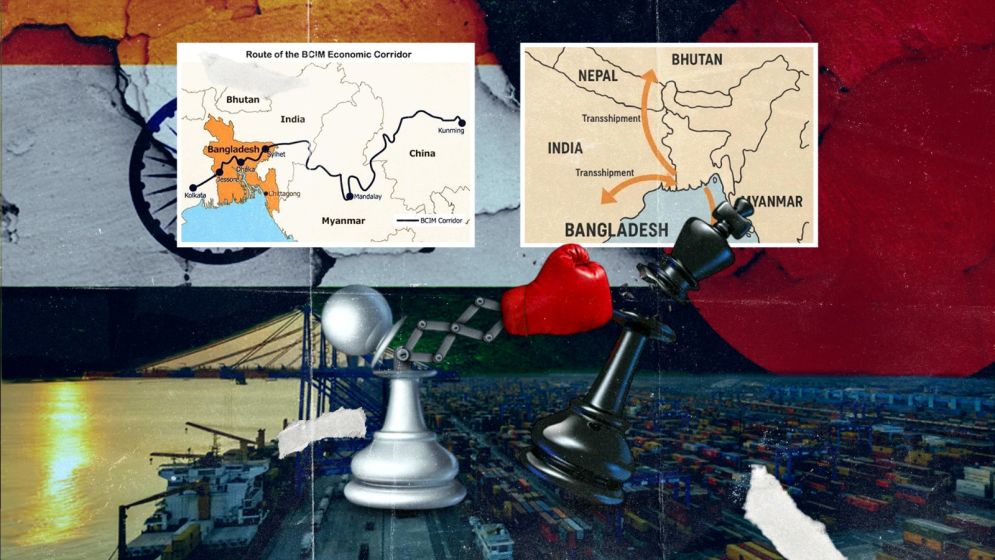In the Trumpian era of tariff war, South Asia needs calm, not countermeasures

Last week, New Delhi made a consequential move: it abruptly withdrew Bangladesh’s access to Indian ports and airports for third-country exports — a facility that had been in place since 2020.
The decision, while portrayed as bureaucratic on the surface, has sent ripples across the borders, undermining a key pillar of regional connectivity at a time when trust and cooperation are already in short supply.
For Bangladesh, this is more than a logistical setback. It feels almost like a betrayal.
Let’s not forget the context in which this facility was introduced. The transshipment arrangement, granted during the peak of the Covid-19 pandemic, was born out of necessity and humanitarian goodwill.
In 2020, South Asia was reeling from the first wave of Covid-19. Bangladesh’s garment industry, one of the largest in the world, was uniquely positioned to meet the demand for medical-grade textiles and apparel.
With global supply chains frozen and Bangladesh’s ready-made garment (RMG) factories facing surging demand for masks and protective gear, India opened up its Land Customs Stations (LCSs) and Integrated Check Posts (ICPs) to facilitate the movement of export cargo.
The sector’s resilience during that period is well-documented: from $33.67 billion in total exports in 2019-20 (of which $27.95 billion were RMG) to $38.79 billion in 2020-21, and an impressive $52.08 billion in 2021-22 — with $42.61 billion of that from garments.
A 35 percent export surge in a single year is no small feat. While the transshipment arrangement may have accounted for only a modest share of that growth in sheer volume, its role in keeping the entire export engine running efficiently was undeniable.
To be sure, India extended a hand in 2020. But Bangladesh responded not with dependence, but with reliability — emerging as a consistent trade partner, an expanding consumer base, and a vital player in South Asia’s export network.
What
had the potential to become a model for sustainable cross-border trade is now,
regrettably, at risk of unraveling into yet another diplomatic point of
friction.
Tit-for-tat or what?
There is no doubt that the gesture helped Bangladesh keep a lot of its factories running during that trying time of Covid-19 –and, importantly, it helped serve health needs across South Asia and beyond.
But the gesture that began as a practical solution in a moment of crisis has now ended abruptly, without prior consultation or warning.
The fact is, the Indian government’s decision to revoke the facility not only disrupts supply chains — particularly for landlocked Bhutan and Nepal, who rely on this corridor for access to Bangladeshi markets — it also risks the erosion of regional goodwill, which South Asia can ill afford.
Meanwhile, right after, in a carefully worded but pointed response, Bangladesh’s National Board of Revenue suspended yarn imports from India through five major land ports–Benapole, Bhomra, Sonamasjid, Banglabandha, and Burimari from this Monday.
To many in Bangladesh, this feels like not retaliation but a necessary assertion of parity– a reminder that Bangladesh, too, holds leverage in this increasingly asymmetric relationship.
There’s an irony however here worth noting. While India touts its “Neighbourhood First” policy and its ambitions to be the region’s logistical hub, its decision of moving the first domino–of cancelling the transshipment facility–chips away at the credibility of that very vision.
This is because regional integration is not built on arbitrary revocations and unilateral moves; it requires trust, consistency, and consultation.
What’s most disappointing is not the withdrawal itself–sovereign nations have the right to revise policy– but the manner in which it was executed. No dialogue, no discussion, no consideration for the broader consequences.
For all the challenges and complexities of regional trade, the transshipment arrangement that India and Bangladesh forged during the pandemic years proved not only effective–but transformative.
According to records from the Bangladesh Garment Manufacturers and Exporters Association (BGMEA), between January 2024 and March 2025 alone, Bangladesh transshipped over 34,900 tonnes of apparel products through India — worth approximately $462.34 million — to 36 different countries.
The
United States, the European Union, the United Arab Emirates, and Australia were
among the primary destinations. In an era where shipping delays are costly and
consumers demand faster turnaround, air freight was no longer a luxury — it
became a necessity.
Beneficial for the region
Bangladesh’s strength in ready-made garment (RMG) exports is the product of more than 35 years of expertise. With over 4,000 operational factories today, we supply nearly every major global fashion brand– from Zara and H&M to UNIQLO and Gucci.
For many of these brands, the Dhaka-Delhi multi-modal cargo route was essential. It enabled us to meet urgent global demand affordably and on time.
In fact, it wasn’t just about exports. Indian retail giants like Reliance and the Aditya Birla Group also benefited from the same corridor, importing Bangladeshi cotton apparel.
There is no denying the fact that our export infrastructure is already stretched. Dhaka’s international airport remains the country’s only major air cargo hub. The Chattogram seaport, while crucial, primarily handles ocean freight and is increasingly congested.
The Pangaon Inland Container Terminal has taken on some international shipments but operates at limited capacity. Mongla and Ashuganj ports–both along the Indo-Bangladesh Protocol Route (IBPR)--handle mostly imports and remain underutilized for garment exports.
The new cargo terminal at Dhaka Airport, despite years of planning, has yet to become fully operational.
Contrast that with Delhi’s Indira Gandhi International Airport–a sprawling 150-acre cargo complex with cutting-edge logistics facilities, two integrated terminals, and rail-road connectivity that links seamlessly to Kolkata and onward to Bangladesh.
Its airline network covers 67 international and 79 domestic destinations, served by over 65 passenger and 20 dedicated freighter airlines.
Crucially, India offered access to this infrastructure without imposing any “extra” transshipment fees. Despite internal concerns about congestion, India absorbed the environmental costs and continued to provide the facility as a gesture of goodwill — one that was deeply appreciated in Dhaka.
The “Transhipment Excellence Centre” (TEC), set up specifically at Delhi Airport, was a pioneering initiative, offering seamless processing of garments destined for the world’s biggest fashion capitals.
And now, suddenly, that corridor is gone.
It’s hard not to feel that something valuable has been lost — not just an economic arrangement, but a moment of rare and genuine regional cooperation.
If this is the price of shifting geopolitical sands, it will be paid not just in export dollars or missed deliveries, but in the erosion of trust between neighbors.
Bangladesh has always aspired to a regional order based on mutual respect, practical collaboration, and shared prosperity. The success of the transshipment corridor was proof that such a model was possible.
Its
abrupt cancellation, unfortunately, reminds us how fragile such progress
remains.
A setback for South Asian solidarity
The cancellation of the transshipment facility was definitely a setback to a shared vision–one where connectivity was supposed to transcend politics.
The move is poised to raise not only the cost and lead time of Bangladesh’s third-country exports, but also tension within bilateral relations that have, for the most part in recent years, leaned toward pragmatic cooperation.
The decision also comes at an especially precarious time for global trade. With the Red Sea shipping route increasingly unsafe due to attacks on vessels, many Indian and Bangladeshi ships are now rerouting around the Cape of Good Hope — a costly and time-consuming detour.
This disruption adds to the strain on supply chains, particularly for time-sensitive exports like garments and pharmaceuticals.
For Bangladesh, which has set its sights on becoming a $1 trillion economy by 2031, this is a critical moment. The country is reaching an inflection point in its development story.
India’s own post-liberalization experience serves as a case study: without addressing the infrastructure deficit–especially in air and maritime logistics–growth can plateau, and hard-won gains can erode.
Bangladesh’s economic aspirations, however bold, risk becoming unsustainable unless it accelerates investments in trade infrastructure.
In a world shaped by Donald Trump-era protectionism and an increasingly uncertain global trade order, the stakes are higher than ever. Bangladesh cannot afford to slip behind — not just in garments, but also in rising sectors like pharmaceuticals, leather goods, and agro-processed foods.
To remain competitive, Bangladesh needs faster, more efficient airports and seaports. The deep-sea port at Matarbari — slated to be operational by 2027 — holds promise. But until then, the options are few, and the Bay of Bengal’s silted coast offers little flexibility.
The urgency to upgrade air cargo terminals, diversify export routes, and modernize customs logistics is no longer a question of ambition — it is one of survival.
Yet in all this, there remains a deeper truth: Bangladesh’s path forward cannot be built in isolation. Our elevation from a least-developed country to a developing one was powered in part by open markets, friendly neighbors, and regional connectivity. That story must continue–not unravel.
This is why the April 8 decision is so disappointing. Regional growth should not be hostage to policy shifts or political anxieties.
South Asia, a region so often divided, had in this corridor a rare symbol of shared progress. Its closure should prompt reflection–not retaliation– on both sides of the border.
—
Md Sazzad Amin is an entrepreneur and an armchair political analyst

